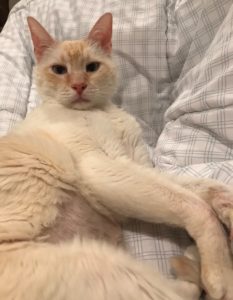
In December 2016, I posted about the fact that we had started giving our cat chemotherapy for his small-cell lymphoma. It seemed to work for a while, but in November 2017, it seemed to be failing. Joey, our cat, was starting to lose weight. He had been about 16.5 pounds (which was, admittedly, too much) before he got sick, but in November it was down to about 15.5 pounds, but, more important, he was vomiting a lot.
So our vet shifted him to a different stronger drug and it appeared to be working. The vomiting subsided and his weight stayed above 15 pounds. Starting around March of this year, though, his weight started falling. The last recorded weight I have for him is about 14.5 pounds in late March. In around mid-May, we took him to the vet: I think his weight had fallen to just above 13 pounds but I had failed to record it. She said that he was probably near the end. I asked if we were talking weeks, months, or years, and she said weeks and maybe a few months.
About a month ago, Joey developed an eye infection and the vet put a funnel-shaped thing around his neck so he couldn’t scratch it. Joey HATED it. The first few hours after he got back from the vet, he would back up, thinking that that would get him out of it. Of course it didn’t. Meanwhile, we put an ointment in his eye that was supposed to get rid of the infection. It didn’t seem to do much.
One morning, about 3 days into his having the funnel over his head, Joey looked depressed. He had had an enormous appetite for the previous year because so much of it was going, presumably, to feed the cancer. But that morning, he hardly touched his food and simply sat on a towel on the floor.
“This must be the weeks or months the vet had told us about,” I thought. My wife and I talked through the idea of taking him to our local non-specialist vet that morning and having him put to sleep. “If we’re considering that,” I said, “we should at least take the funnel off. His last few hours of life shouldn’t be spent in that thing.” She agreed. Then we thought it through further and realized that even if these wouldn’t be his last few hours of life, the worst he could do by scratching himself would be to wreck his eye. That’s bad, but cats, especially indoor cats, can do fine with one eye.
So we took off his funnel and then, to our delight, within a couple of hours he regained his spirit. The idea of having him put down made no sense. We also found out that there are two vets in the Monterey Peninsula who specialize in ophthalmology for animals. That weekend we took him to one of them. She gave us a very expensive drug ($140—cheap for humans, expensive for cats) that we started giving him and his eye cleared up within a few days. He is now thriving. This week, my wife took him to the vet who prescribes the cancer drug and she was amazed at how good he looked.
How the heck does this relate to economics? Here’s how. Pillar #3 of the Ten Pillars of Economic Wisdom is that economic thinking is thinking on the margin. Once we realized that we were willing to have Joey put to sleep, the marginal benefit of having that funnel on him was clearly well below the marginal cost. But we also wondered, even aside from putting him down, if the funnel was hurting his quality of life. We realized too that that in itself would probably shorten his life. So then we realized that the marginal value of saving his eye was low relative to the benefit to him of being comfortable and regaining some of his spirit.
The picture of Joey above was taken in the last few days.

READER COMMENTS
Jon Murphy
Sep 23 2018 at 1:53pm
I’m glad this story has a happy ending.
Another economic lesson to be learned here is that signals can be coarse. Joey was looking depressed and not eating. The conclusion that he was just too ill and needed to be put to sleep was reasonable. But the only signal you were getting was an unhappy cat. He didn’t/couldn’t tell you why.
Making a marginal change helped. And it happened to show your interpretation of the signal was ultimately (and fortunately) incorrect.
Arnold Layne
Sep 24 2018 at 12:25am
I’m glad Joey is doing better. These animals occupy huge spaces in our hearts and can be very hard to let go of. Wishing for his continued high quality of life.
David Henderson
Sep 24 2018 at 11:22am
Thanks much, Arnold. And, as always Jon Murphy, I appreciate your comment.
Comments are closed.